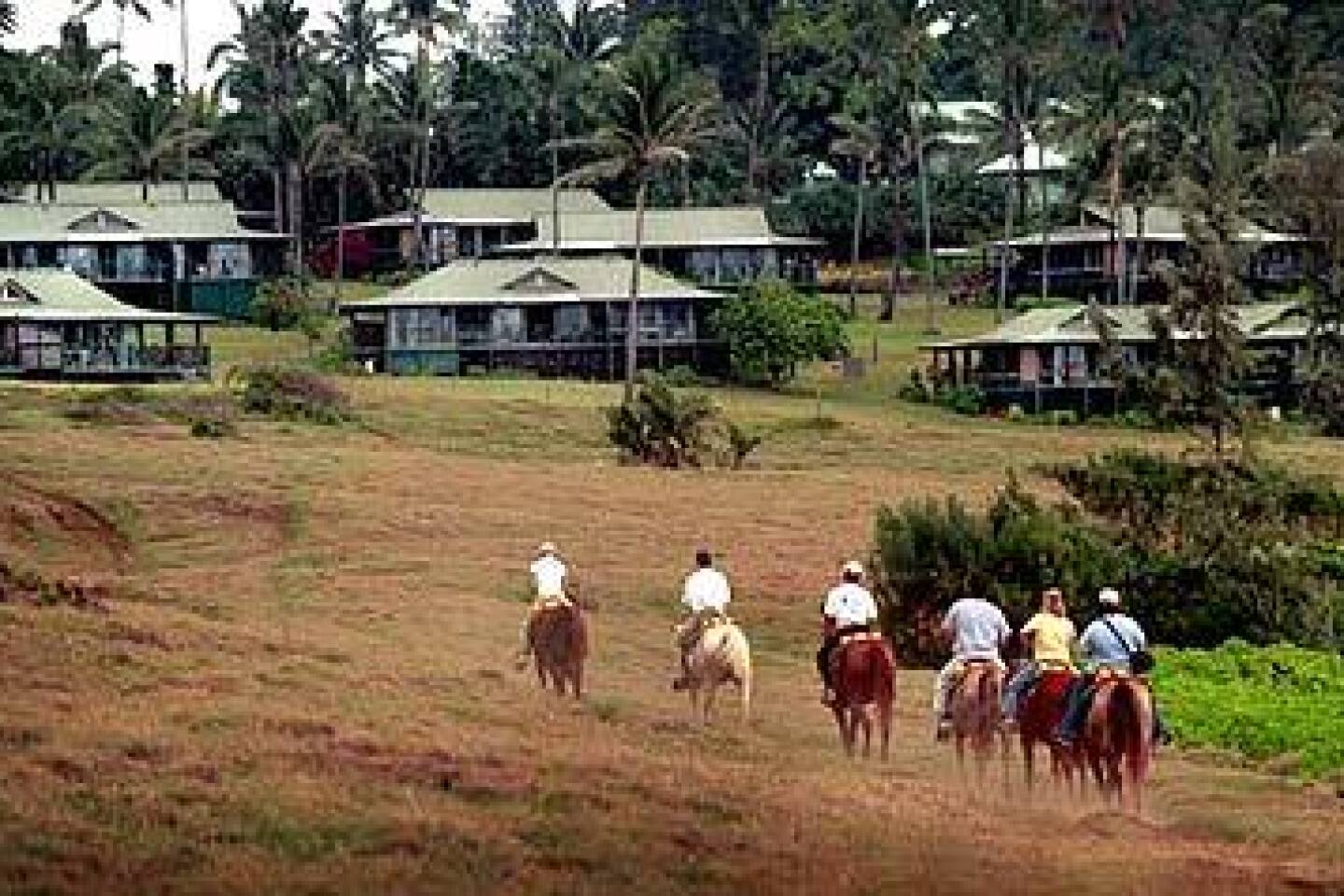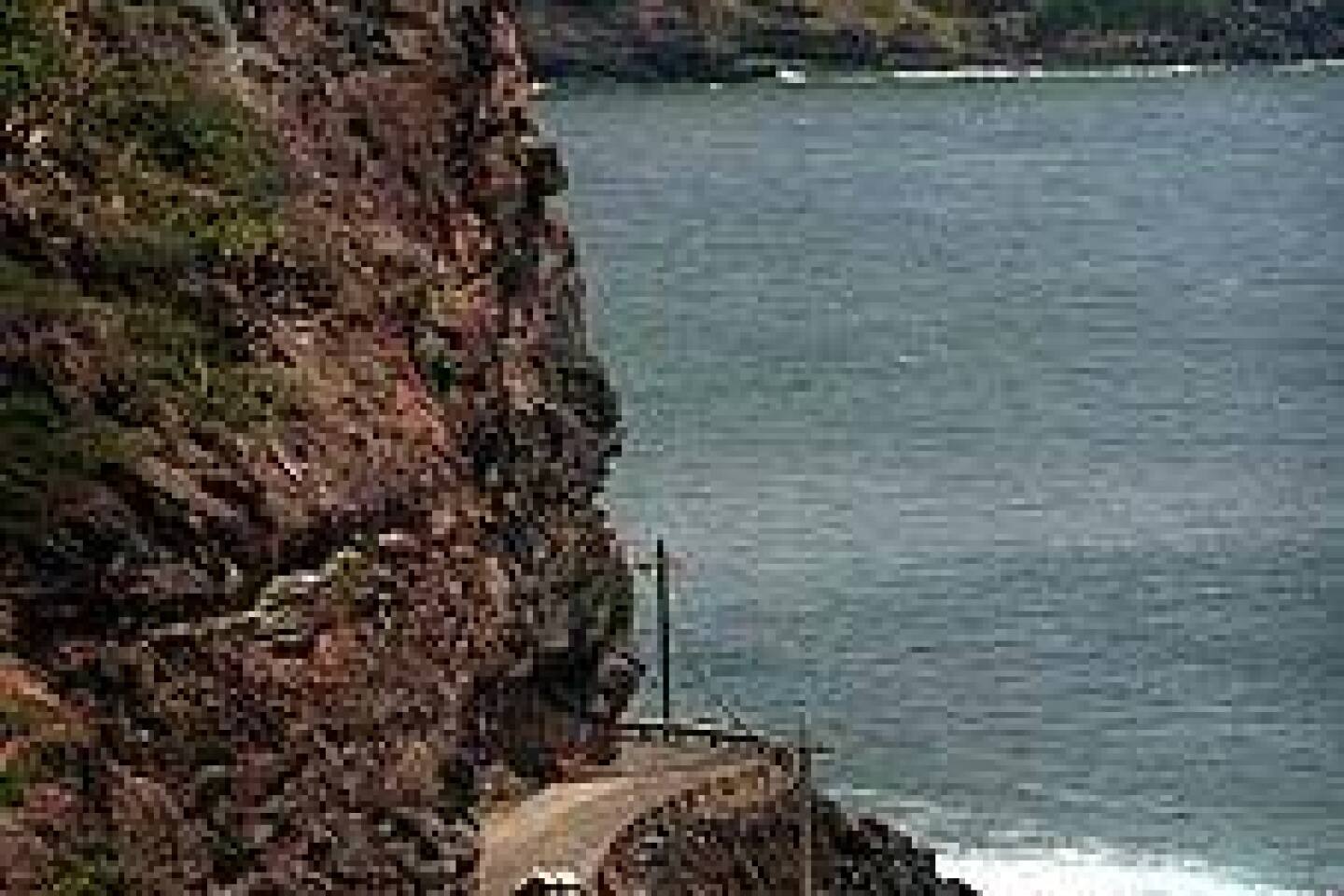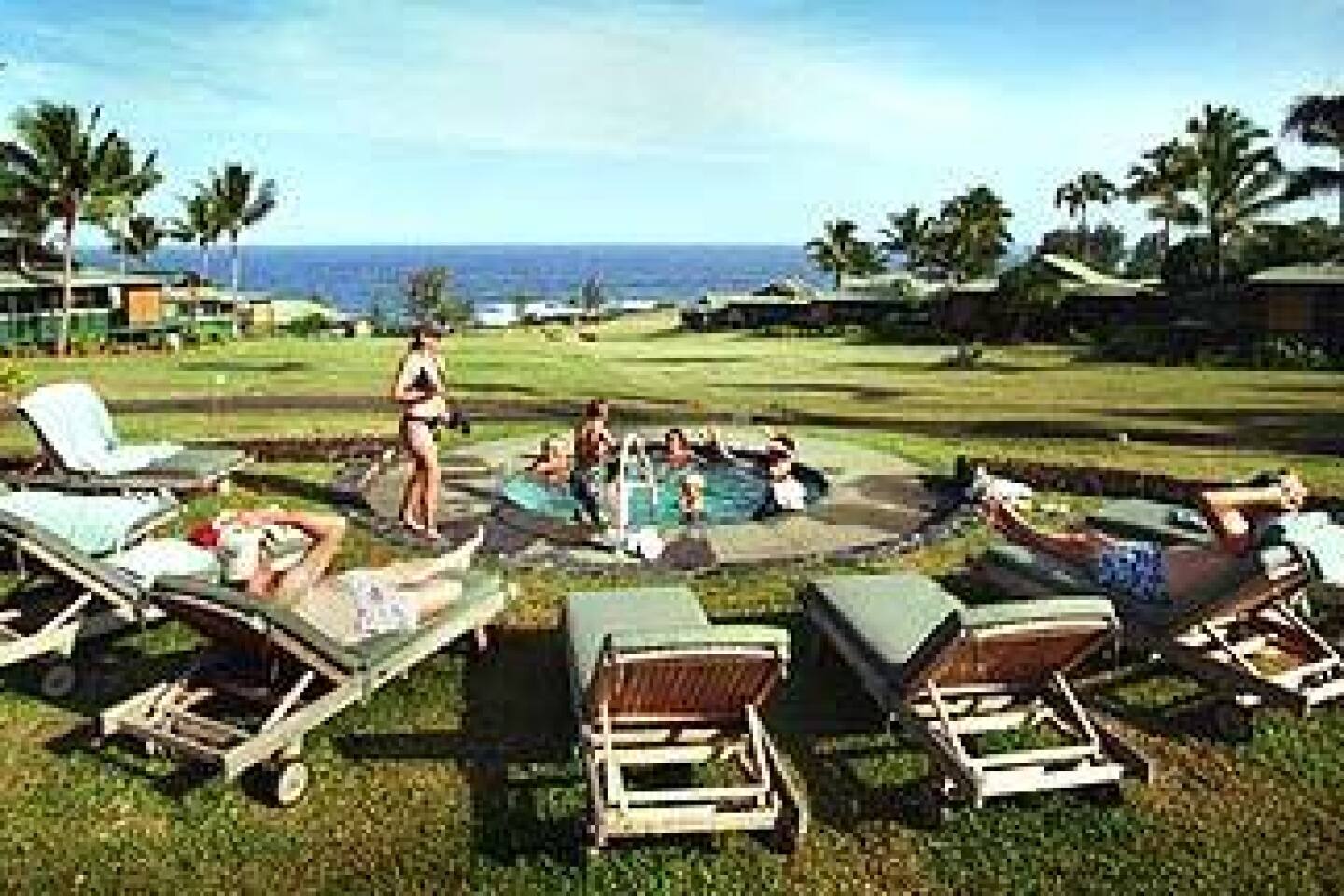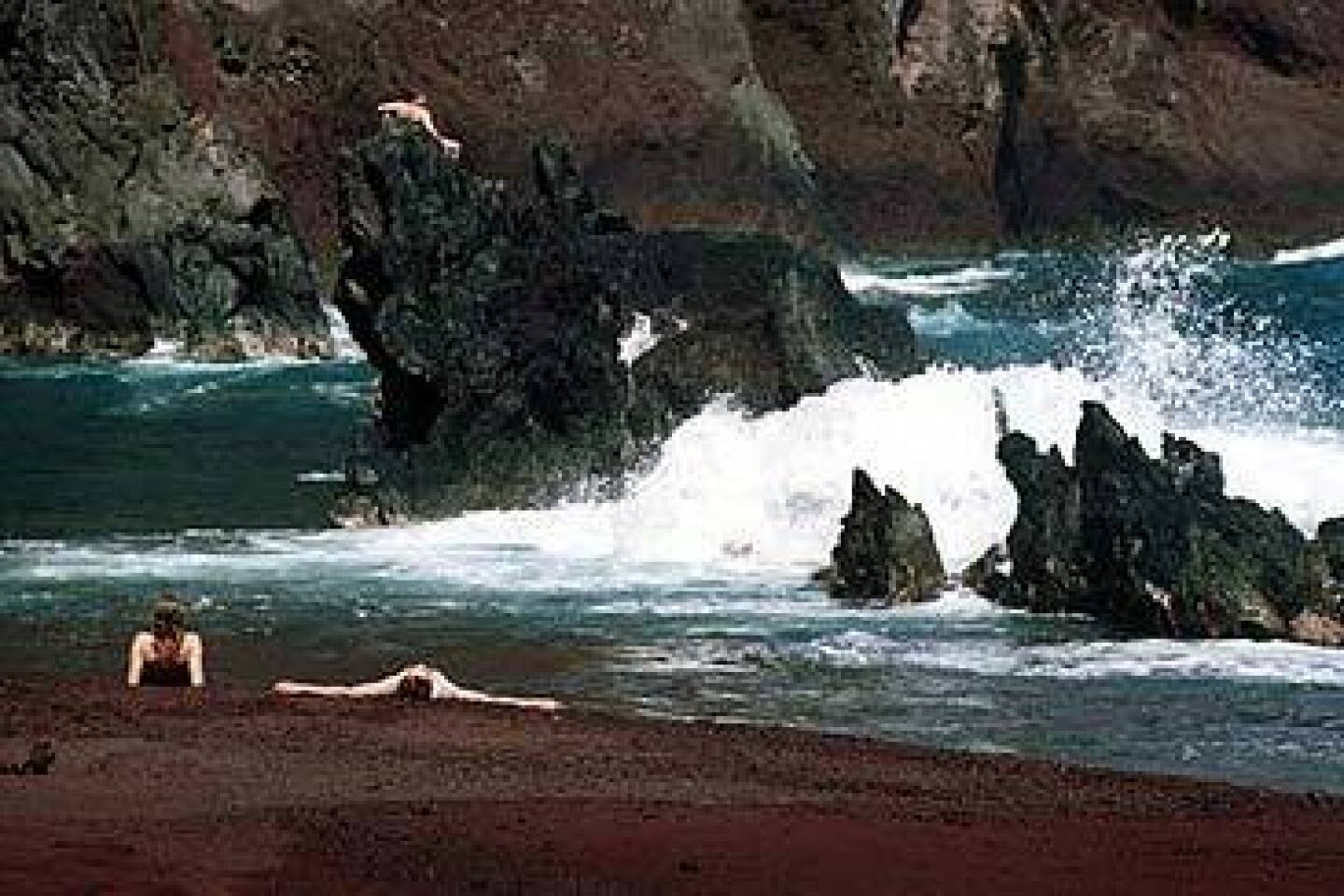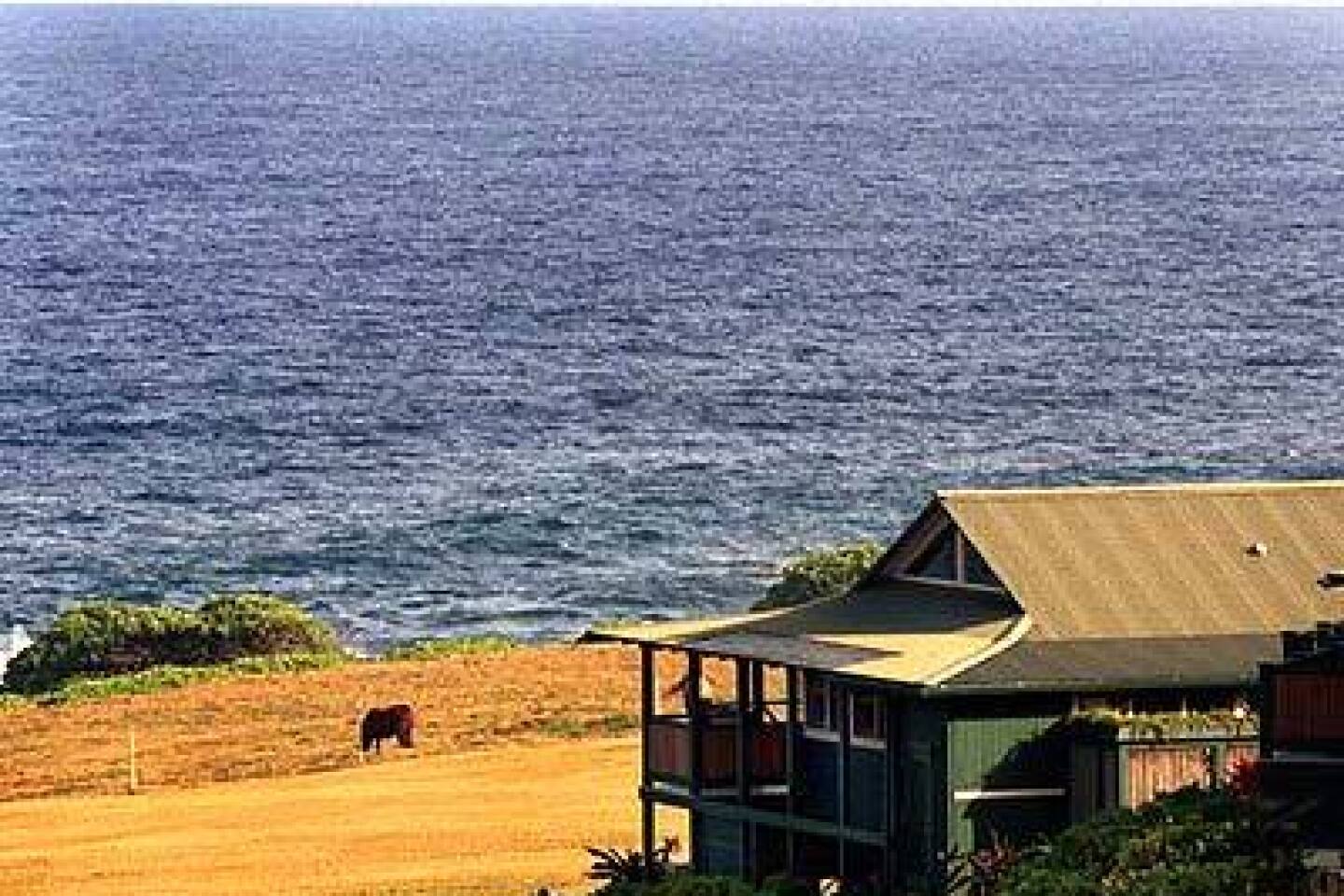Soft on Maui’s rugged corner
HANA, Maui — I fell asleep to the soft whirring of a ceiling fan and awakened at sunup to the chirping of myna birds outside my window. Wrapped in my Hana-Maui robe, I padded across gleaming wood floors to the wet bar, brewed a pot of coffee and slipped through the shuttered doors onto the lanai. There was no one in sight, just those birds hopping about on the rolling green lawn.
Here on the rugged eastern coast of Maui, an area that’s geographically remote and, with its laid-back ambience, otherworldly, it was hard to think about war and other ugly things. The tropical beauty was seductive. At Hotel Hana-Maui, the day’s biggest decision was whether to take a horseback ride, ukulele or lei-making lessons, yoga or aqua aerobics.
I flew from Los Angeles to Kahului on a weekend in March, picked up a rental car and drove the 50 or so miles to Hana town on the once-infamous Hana Highway. Now that it’s fully paved and its potholes are filled, it’s hardly even scary. True, there are those one-lane bridges (more than four dozen) and about 600 bends and hairpin turns. But on this day, traffic was light and a spitting rain soon yielded to sunshine.
Although I had driven this two-lane road perhaps a dozen times, I remained awed by the beauty of the rain forest, a mosaic of bamboo, ti, guava, ginger and plumeria, of rushing waterfalls and cliffs plunging to lava-rimmed beaches. Eager to reach Hana before dark, I made the trip in 2 1/2 hours.
As I neared town, my thoughts drifted to my first stay at the Hana-Maui -- with my young son in 1978, when it was a homey, chenille-bedspread kind of place. I knew Dallas-based Rosewood Hotels had given it a $24-million redo in the ‘80s and that it had changed hands several times. I knew that the new owners, Ohana Hotel Co. of Maui and its management team, Passport Resorts (which runs the Post Ranch Inn at Big Sur), had undertaken a renovation since acquiring the property in the summer of 2001. Was I in for a terrible shock?
My fears were dispelled as I pulled into the porte-cochere to a friendly “aloha” from a bellman. At reception, a hostess draped an orchid lei around my neck and offered a glass of cold juice. Soon I was settled in with just enough time to change before the Sunday dinner and Hawaiian show. Another reassuring sign: The performers, as always, are locals, many of them hotel employees. Grandmothers of all sizes in shapeless costumes do the hula alongside their children and grandchildren.
The next morning I checked out the town. It was as though time had stood still, although I had last visited almost 20 years ago. There’s the post office, bank, stables, a small souvenir shop, the Hana Ranch Store, Hana Ranch Restaurant and a gas station. Hasegawa’s legendary general store burned down and has been relocated to the old Hana theater. Down at Hana Bay, Tu Tu’s snack shop still serves breakfast and burgers.
And that’s about it.
Early one morning, I grabbed my fins and mask and headed for the old pier at the bay, where I negotiated a ladder that plunged me into the water for a short swim to a rocky area that’s an aquarium of tropical fish. My other reward: a coconut ice cream cone at Tu Tu’s. On another beautiful day, I made the 45-minute drive along the narrow, winding road through dense vegetation to what used to be called Seven Sacred Falls, now known as Oheo Gulch. (They never were sacred, it seems, and there are more than seven.) They are spectacular, although east Maui had a dry winter and the falls were tamer than usual.
Continuing along the road less than two miles, I came to a small lane on the left leading to Palapala Hoomau Church and its tiny cemetery, where half a dozen tourists were gathered at the simple gravesite of Charles Lindbergh, a part-time resident who died at Hana in 1974. It’s not promoted as a tourist attraction. Lindbergh’s Hawaiian life was so low-key that a Hana native I met told me his mother used to fish with someone she knew only as “old man Charlie.”
Some will tell you there’s nothing to see in Hana except scenery, but I found several things worth a peek. One is the 472-acre Kahanu Garden, 1 1/2 miles down a rutted, partly paved road -- one of those roads the car rental agencies hope you won’t discover -- at mile marker 31 on Hana Highway. This national tropical botanical garden sits on a rugged lava rock coast overlooking the ocean. Breadfruit and other trees that ancient Pacific Islanders used for survival grow in abundance. But for me the reason to pay the $10 admission was to see the massive rock Piilanihale Heiau, a 415-foot-long temple thought to date from at least the 16th century.
On Uakea Road in town, the little museum at the Hana Cultural Center (donation: $3) has an eclectic collection that includes antique Japanese and Chinese medicine bottles, old fishing hooks and poi pounders and the original sign from the Hana Hotel, a six-room turn-of-the-century establishment and beer parlor that closed in 1953.
Here I learned that Hawaiian women, introduced to quilting by missionaries in the 1820s, thought it folly to cut up perfectly good fabrics only to patch them back together, so they began creating original designs. Four thatch-roofed hales -- a sleeping house, men’s eating house, cooking house and canoe house -- have been built. (It’s noted that the men cooked for the women.) Also here is the restored 1871 one-room courthouse where the judge’s bench is flanked by both flags and a pair of yellow feather kahilis (royal standards). Today a judge comes to Hana once a month to hear cases.
A hotel’s evolution
Back at the Hana-Maui, I was a little unsettled to find that the wing where we had stayed in a small, plain room all those years ago is gone; on the site is the elegant Hana Coast Gallery, a showcase for artists and artisans from Hawaii, Polynesia and the Orient. This is the place for beautiful porcelain vases, collectibles and bowls turned from exotic woods.
For the hotel, which opened in 1946, the most momentous change came when Rosewood enlarged and rearranged it, adding ocean-view cottages, extending the dining pavilion with a lanai and turning the library into the inviting Paniolo Lounge.
But a steady decline began after the property’s sale in 1989 to Keola Hana-Maui, an international investment group with Japanese principals, which a decade later sold the hotel and adjacent Hana Ranch to Chicago-based Meridian investors.
When Ohana bought the 35-acre hotel property and 32 additional acres that include the little town center, everything had suffered a decade of neglect, says Peter Heinemann, a Passport managing partner, but the hotel had “good bone structure.”
Much of the $10-million renovation budget went to deferred maintenance -- roofing, plumbing, electrical and kitchen updating. “When you’re spending $400 a night, you don’t want to be wondering if you’re going to get a hot shower,” says Douglas Chang, the general manager.
Chang, 42, a native of Hawaii lured away from the Kauai Marriott Resort, says neglect had robbed the hotel of its “strong soul.” “They didn’t have the occupancy to offer the services,” he says.
It was a difficult time for the community. Most of the hotel’s employees are locals, some of whom have worked there 30 or more years. The staff of 170 includes second and third generations. Finesse isn’t their strong suit -- you may get your bread plate on the right and your check as you tuck into your entree -- but they’re long on aloha.
To update the hotel, Passport tapped Maui interior designer Hunton Conrad, who was only 2 when he first stayed at the hotel 49 years ago. His goal was to “make it feel Hawaiian.” Out went most of the Hawaiian quilt bedspreads. “The quilts are clearly a missionary influence,” he says. “I wanted to honor an era before that.” In came dramatic custom prints inspired by old kapa (bark cloth) designs in combinations such as deep melon and charcoal.
A 17-by-17-foot infinity pool spilling over lava stones became the focal point of the open lobby courtyard. Conrad relandscaped the entry, choosing as planters huge pots once used for boiling down sugar. To tame the gymlike proportions of the dining room, where Rosewood had lifted the skylighted roof to soaring heights, Conrad lowered the ceiling with “waves” of blue and green crinoline.
My garden junior suite ($266 a night on a four-night special) was a work in progress, an incongruous mix of pink and white Hawaiian quilt, gold and green pineapple-pattern print on the dining chairs and a chipped and peeling white plaster desk that looked as though it had been fought over by ancient Hawaiian chiefs. The quilts are being replaced by kapa print spreads in sand and olive, the desks by sleek teak models.
Conrad had the luxury of space -- my suite was 33 by 23 feet, including a huge tiled bath with soaking tub overlooking a walled garden and a dining-sitting area with 10-foot wet bar. The minibar was stocked not with booze but with complimentary water, juice and colas. There were a drip coffee maker, coffee beans and grinder and -- hallelujah -- half-and-half in the fridge. There now are phones and room service, but no TVs or radios.
The pricey cottages were gutted, their white and beige decor replaced by oranges and greens with pale citron walls. There are bamboo platform beds, and the shutters opening onto private decks (some with Jacuzzis) have been replaced by draperies, adding 3 feet of floor space. Plans include outdoor showers.
With Passport came Hawaii native Larry Quint, former executive sous-chef at the Post Ranch Inn. The cuisine, with Hawaiian and spa food influences, is uneven but has moments of inspiration. The Sunday night prime rib buffet was saved from the mundane only by the abundance of shell-on shrimp, but on another night my seared ono (a local fish) atop a potato-lobster pancake was terrific. Presentation is attractive, but, alas, the orange juice is frozen and the Cobb salad made with turkey roll. Yet who cares when there’s pina colada creme brulee?
When complete, the hotel will have 79 rooms. A new spa with large soaking pool and gardens is scheduled for fall opening. The focus will be on traditional Hawaiian healing treatments.
Preservation is a big word in Hana, where there is a pervasive fear of destruction of lifestyle through runaway development.
For the first time, the hotel and adjoining 4,500-acre Hana Ranch have different owners. The cattle ranch, with four miles of oceanfront, was sold in January 2001 for $24 million to Hana Ranch Partners, whose major investors are the Gordon P. Getty Family Trust and Susan and Roy O’Connor, Montanans with a second home in Hana.
The buyers are conservationists with a concern and love for the area, says Dan Omer of Hana, chief executive of the partnership. While theirs is not a “completely altruistic” enterprise, he says, their investment goal is “patient money.” Their first sale was to Oprah Winfrey -- $15 million for 102 acres on which she plans to build a home. There will be other land sales, but not in the immediate future, Omer says. High-rises or subdivisions are not on the horizon. And while the ranch came with a permit to build a golf course, won after a long fight by the hotel’s last owner, Omer says “there is no intention to do that.” Hana will remain a non-golf destination.
The Hana area, with about 1,800 residents, has been protected by its remoteness, although 700,000 visitors, mostly day-trippers, drive here each year. Recently elected Maui County Mayor Alan Arakawa says, “Hana is very special. They’ve been able to resist this temptation to get in for the fast bucks and rip and roar.”
If there has been change, designer Conrad observes, it’s an awakening excitement about Hana’s uniqueness. “Ten or 15 years ago, people here felt like it was off the edge of the earth. Now people are looking for places that feel like they are off the edge of the earth.”
More to Read
Sign up for The Wild
We’ll help you find the best places to hike, bike and run, as well as the perfect silent spots for meditation and yoga.
You may occasionally receive promotional content from the Los Angeles Times.
